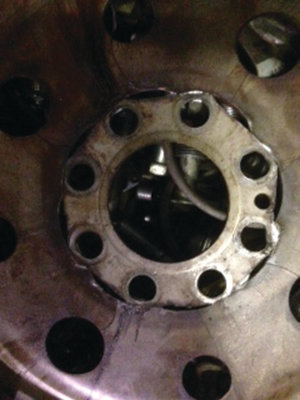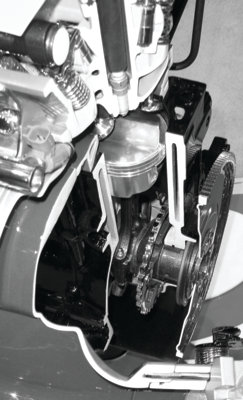It never ceases to amaze me when I see certain types of problems in rapid succession of one another and then not see them again for months or even years. Like they say on the TV show Pawn Stars, “You never know what will come through the door.” This column is dedicated to one such occurrence.
Within a week of each other, two different vehicles came into my shop with cracked flex plates. While I have seen flex plates crack throughout my career, it is not a common scenario.

2007 Ford E-250
The first vehicle was a 2007 Ford E-250 work van with a 5.4-liter engine. This van belonged to one of my fleet accounts and is regularly in for service. The owner called to inform me that the vehicle was getting towed in and that it had just stopped running on the freeway. Once the vehicle arrived at my shop, I cranked it and noticed the engine was cranking very fast, as if it had no compression. At least that is what it sounded like.
I started thinking how much work would be involved with either changing the engine or replacing the timing chain. I started to go through the motions: Removing the dog house cover to gain access to the spark plugs to do a compression test. I started to crank the engine with my gauge installed on the first cylinder, but I was shocked to see a reading of zero pounds of compression. After testing three more cylinders and seeing the same results, I wondered if the engine was actually cranking because I was not able to verify that the accessories were in fact rotating while sitting inside the van. Even a jumped chain still should have some sort of reading, and I knew my gauge was not broken.
I crawled out of the driver’s seat, attached my old remote starter button to the starter and watched as I engaged the starter motor. Bingo! No movement of the engine confirmed that the flex plate must be broken. Basically, the starter was engaging and rotating the torque converter but, since the flex plate was broken, the crankshaft was never spinning due to the fact the entire center section was broken.
But why did the customer say it quit running on the freeway? Even if the flex plate broke, if the engine was already running, it should have stayed running. I asked deeper questions and found out that the vehicle actually lost all power and, once pulled over onto the side of the road, he shut it off and tried to restart to see if it would magically fix itself.
2001 Chrysler Town and Country
The very next vehicle I pulled into the shop was a 2001 Chrysler Town and Country with a 3.3-liter engine with a complaint of rough running/stalling accompanied by cam crank correlation codes. Both the cam and crank sensors had previously been replaced along with the PCM.
The vehicle would sometimes run normal and other times would barely stay running.

I attached a scan tool to verify the code and physically watch the cam/crank synch PID to see if it showed that they were in fact out of synch. To my surprise, the code was present, but the PID also said they were in synch. This is a prime example of the potential limitations of a scan tool and the refresh rates of the tool.
As luck would have it I recently purchased a new PC-based scope and, in the training video enclosed with the scope, the instructor had a case study pertaining to this very same problem. Basically, the instructor, Bernie Thompson, said that if we attached our scope leads to the cam/crank signal wires to display a pattern, the two square wave signals should not touch each other. Once the signals were displayed on the screen, I did see that the two signals overlapped, confirming the two signals were out of time with one another. But why? Are the cams out of time, or is it the crank signal?
In the training video, Thompson said to use a pressure transducer and watch for the point that the valve overlap occurs to determine if the camshafts are out of time. Then, I used a little common sense to shortcut my diagnostic process.
Remember how this vehicle would run great at times and other times would barely run? If the camshafts were indeed out of time, the engine should never run decently, but I decided to attach a vacuum gauge anyway just to confirm my thought process. The engine vacuum was between 17 and 20 inches, depending on how the engine was running at the time, so I felt safe assuming the camshafts were in time.
These vehicles do have problems with their camshafts jumping time due to a chain issue, as well as broken flex plates, so it is important to determine exactly where the problem lies before deciding what to take apart. Once the transmission was removed, it was evident that the flex plate had cracked, which was causing the out of synch codes to set.
When these flex plates crack, they typically wedge themselves in place, which still allows the engine to run because the crankshaft can still spin.
Looking back on these two jobs, I have two thoughts: First, what a strange field this is to have two vehicles with the exact same problem back to back. Second, I’m glad I had the tools needed to diagnose this vehicle in a timely manner, especially since I had just finished watching the training video discussing this very same problem!










